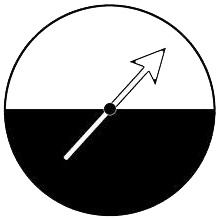Black and white
0
Overview
Using this Resource
Connecting to the Curriculum
Marking Student Responses
Working with Students
Further Resources
This task is about comparing probabilities.

The arrow on this spinner has an equal chance of stopping on black or white when it is spun.
Task administration:
This task is completed online and has auto marking displayed to students.
Level:
4
Curriculum info:
Keywords:
Description of task:
This task sees what a students understanding of probability is.
Curriculum Links:
This resource can be used to help to identify students' understanding of ordering probabilities.
Learning Progression Frameworks
This resource can provide evidence of learning associated with within the Mathematics Learning Progressions Frameworks.
Read more about the Learning Progressions Frameworks.Answers/responses:
| Y8 (11/2015) | ||
| a) | C - Each of these two options are equally likely. | easy |
| b) | C - The arrow points to black once and white once. | moderate |
| c) |
All 5 correct
 |
moderate
|
Based on a sample of 100 Year 8 students
Teaching and learning:
The key element in this task is recognising which outcomes of a chance event are more probable that others.
Diagnostic and formative information:
Equiprobabily misconception
b) Students tick "Each of these three options are equally likely."
The student sees events as equally likely, even when the events have different probabilities. This error involves either:
The student sees events as equally likely, even when the events have different probabilities. This error involves either:
- ignoring the different probabilities of events; or
- ignoring that 1 black and 1 white can occur two different ways, and is therefore twice as likely as 2 blacks (which can only occur one way).
See Throwing a coin for a resource that also has this as a common misconception.
Next steps:
Equiprobabily misconception
Get the student to record the results for a game with equal probabilities by making a spinner. Click on Making spinners for instruction on how to make a fair spinner. With a large number of spins, students should observe that 1 black and 1 white is twice as likely as 2 blacks or 2 whites. The results of this could be discussed, and students encouraged to note that black followed by white, and white followed by black both lead to a total of 1 black and 1 white.
Students could also write down the 4 possible options using either:
- a list, e.g.: B B; B W; W B; and W W;
- a tree diagram: See Combinations of marbles
- a table, e.g.
| B | W | |
| B | B B | B W |
| W | B W | W W |
For more information click on the Probability concept map
Two dice game and Throwing a coin both provide more information about sequences of events with a probability of 1/2.
- Combinations of ties and socks
- Spinner for a board game
- Colour a spinner
- Library books
- Farm helicopter
- Missing cat
- Speed trap
- Cup of marbles
- Fun run prizes
- Dice combinations III
- Speed camera
- Dice combinations IV
- Draw of socks
- Scrabble tiles
- Flowers and trees
- Kī o rahi tournament
- One dice chances
- Prize wheel
- Two coin game
- Four spinners
- Prize draw
- Summer births
- Scrabble
- Five coin throws
- Netball tests
- Two zone spinner
- Two dice game IV
- Target arrows
- Complementary probabilities
- Candle combos
- Three coin throws
- Board game
- People in cars
- Making spinners
- Coloured spinner
- Three dice game I
- Two dice game III
- Four dice game I
- Three coin game I
- Five dice game I
- Two dice game II
- Two dice game I
- Throwing a coin
- Describing probabilities
- Coin throws
- Probability Concept Map

